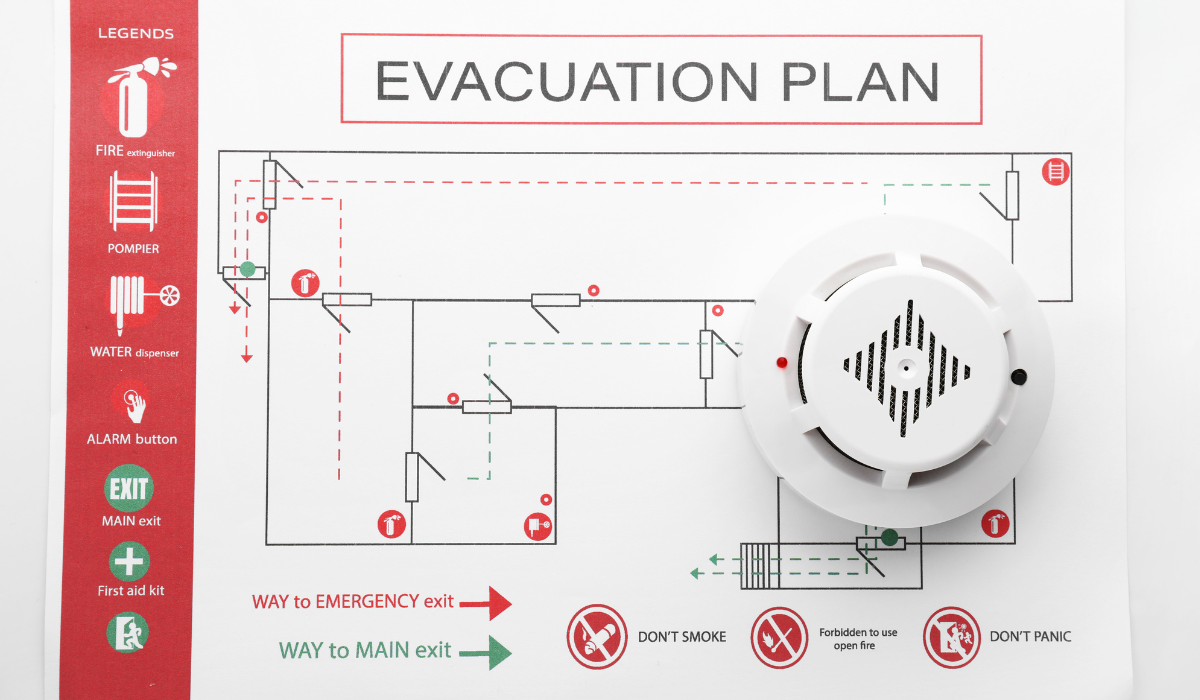Occupational health and safety protocols encompass a wide array of measures to ensure the well-being of workers and visitors within various settings. Among these, effective workplace evacuation plans stand as a critical element to safeguard lives during emergencies. As the tragic fires in Hawaii show, deadly emergency situations can occur any time, and with little-to-no warning.
Whether it’s a fire, natural disaster, or other unforeseen incidents, a well-coordinated and practiced workplace evacuation plan can mean the difference between chaos and a safe, orderly departure.
Here, we’ll explore the importance of preparing for evacuation scenarios, and highlight key strategies for creating a robust workplace evacuation plan of your own.
Related Article: 5 Key Steps to Workplace Emergency Preparedness

The Tragic Wildfires in Maui
Only weeks following the Canadian wildfire’s impact on parts of New York, the current wildfires in Maui have resulted in the tragic loss of at least 96 lives (as of the time of this article’s publishing), with the toll anticipated to climb further.
Hawaiian authorities say this calamity has devastated the resort town of Lahaina, creating a reconstruction project that will require years of effort and billions of dollars.
The rapid-spreading inferno, ignited on Tuesday, August 8, originated from the outskirts of the town, consuming the historic city of Lahaina, once the seat of the Hawaiian Kingdom.
This catastrophe stands as one of three significant wildfires on Maui, with each blaze fueled by arid conditions, accumulated combustible material, and massive gusts of wind clocking at 60 mph (100 km/hr).
While mandatory evacuations were indeed enforced for affected regions on the west side, numerous residents whose homes were destroyed conveyed to The New York Times that they remained uninformed of any evacuation notices.
This situation underscores the incredible need for a sound evacuation strategy during times of crisis.
Related Article: The Impact of Wildfire Smoke on Respiratory Health
Understanding the Significance of Evacuation Preparedness
In any workplace or public space, emergencies can strike without warning.
From hazardous material leaks to structural failures, a comprehensive evacuation plan is crucial to mitigate risks and ensure the prompt and secure evacuation of personnel and visitors. But, by having a well-defined protocol in place, you can minimize confusion, prevent injuries, and potentially save lives.
See OSHA’s Final Rule on; Exit Routes, Emergency Action Plans, and Fire Prevention Plans
See OSHA’s Guideline on Emergency Preparedness and Response
Designing an Effective Workplace Evacuation Plan
Creating an effective workplace evacuation plan involves several key steps:
- Risk Assessment and Planning: Identify potential hazards within the environment, considering factors like building layout, fire exits, and assembly points. Conduct regular risk assessments to ensure the plan remains up-to-date.
- Clear Communication: Establish a communication hierarchy to disseminate evacuation instructions swiftly. Utilize multiple channels, such as loudspeakers, alarms, text messages, and designated personnel, to ensure everyone receives the message.
- Emergency Routes and Exits: Clearly mark emergency escape routes with illuminated signs and keep exits unobstructed at all times. Establish multiple exit paths to accommodate different scenarios and capacities.
- Assembly Points: Designate safe assembly points outside the facility where employees and visitors should gather after evacuation. Ensure these points are situated at a safe distance from potential hazards.
- Training and Drills: Conduct regular evacuation drills to familiarize everyone with the procedures. Simulate various emergency scenarios to test the plan’s effectiveness and identify areas for improvement.
See OSHA’s Emergency Action Plan – Evacuation Elements
See OSHA’s Expert Systems – Create Your Own Emergency Action Plan [EAP]
See OSHA Guideline on How to Plan for Workplace Emergencies and Evacuations
Inclusive Evacuation Strategies
Of course, most workplaces consist of a diverse workforce, often with varying degrees of physical limitations or needs.
As such, you’ll need to consider those needs when developing evacuation plans:
- Accessibility: Ensure evacuation routes and assembly points are accessible to individuals with mobility challenges. Install ramps, elevators, and widened doorways to accommodate everyone.
- Communication Accessibility: Provide evacuation instructions in multiple formats, including visual and auditory cues, to cater to individuals with hearing or vision impairments.
- Buddy System: Consider implementing a buddy system where employees are responsible for assisting colleagues with disabilities during evacuations.
Continuous Improvement and Community Involvement
- Feedback and Evaluation: Encourage workers and visitors to provide feedback after evacuation drills to refine the plan. Address concerns, suggestions, and lessons learned to enhance preparedness.
- Collaboration with Local Authorities: Work with local emergency services to align evacuation procedures with community response plans, ensuring a cohesive approach in the event of larger-scale emergencies.
Key Takeaways
A comprehensive evacuation plan is a fundamental pillar of occupational health and safety, safeguarding the lives of workers and visitors alike. By meticulously designing, practicing, and continuously improving evacuation procedures, you can demonstrate a commitment to your personnel’s well-being and contribute to a safer, more resilient work environment.
Through collaboration, inclusivity, and proactive planning, the collective effort to assist workers and visitors in evacuation scenarios ensures a more secure future for all.
***
About Worksite Medical
In most cases, OSHA requires medical surveillance testing, and at no cost to employees.
Worksite Medical makes that program easier with mobile medical testing.
We conduct on-site respirator fit tests, as well as audiometric exams, pulmonary function tests and heavy metal lab work, right on your job site. We also keep accurate, easy-to-access medical records for your convenience. You’ll keep your employees at work, and stay ahead of OSHA inspections.




